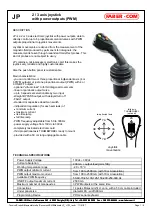
______________________________________________________________________________________
EA16
3
2. CONNECTION TERMINAL
1. P1, P2
:
Power Input Terminals from 60 to
300VAC 50/60Hz -16A rated.
2. F+, F
−
:
Maximum Output current 16A.
3. VS1, VS2
:
Voltage sensing input terminals, Volts
selected using DIP SW1 for 220V or 400V.
4. K, L
:
Load Current Compensation (Droop), CT
secondary current input selected by using DIP
SW 1A or 5A (If droop not used leave terminals
open).
5. VR1, VR2
:
External Voltage trim use, 2K Ohms 1
watt trimmer for ±5% voltage adjustment. Keep
terminals shorted when not in use.
6. A1, A2
:
Analogue Voltage Input terminals used
for Power Factor correction from a external PLC-
The PLC controls provides a DC voltage signal to
adjust the generator voltage. Max. Adjustment
range is ±5VDC. Keep terminals open when not
used.
7. DIP Switch
SW1
:
OFF 220VAC (170 to 260VAC)
ON 400VAC (340 to 510VAC)
SW2
:
OFF CT Secondary Input 1A
ON CT Secondary Input 5A
SW3
:
OFF Generator Frequency 60Hz,
52 ~ 61Hz Adjustment
ON Generator Frequency 50Hz,
42 ~ 51Hz Adjustment
SW4
:
OFF Over excitation protection enabled
ON Over excitation protection disabled
8. LED Indicator
U/F
:
Under Frequency Indicator
O/E
:
Over Excitation Indicator
3. ADJUSTMENT AND SETTING
1. TRIM works together with a bias voltage applied
to terminals A1 and A2. This signal is supplies by
an external Power Factor Paralleling PLC. Use
the TRIM potentiometer to adjust the DC voltage
input that controls the level of the generator’s
output voltage. When set counter-clockwise the
control level is zero, and if moved clockwise the
maximum control range is 10%. The signal
connected to A1 and A2 can be unipolar (0,+) or
bipolar (+,
−
). Check with the manufacture of the
Paralleling control PLC.
2. DROOP
:
Select switch K or L pending on the
secondary current of the CT that you are using.
Voltage droop works when the CT and the AVR
senses that the output of the generator voltage
and current waveforms are out of synch and the
AVR droops the output voltage of the generator
to correct it.
3. STAB
:
If the generator output voltage oscillate,
adjusting the STAB potentiometer will stabilize
the output voltage, over adjustment will result in
high voltage variation when load is applied. Use
an analog type multimeter when making this
adjustment. Connect the meter to terminals F+
and F
−
and slowly adjust STAB potentiometer to
the point when the pointer stops moving.
4. VOLT
:
Move to set the generator output voltage.
Set DIP Switch 1 to the generator working
voltage.
Set SW1 to OFF (220V) for use from 170 to 260V
Set SW1 to ON (400V) for use from 340 to 510V
When using and external VR set it to the central
position and adjust the AVR VOLT trim to the
rated voltage.
NOTE
If the external VR is not used, short terminal
VR1 and VR2.
5. U/F
:
Under Frequency protection setting.
At 60Hz U/F factory set at 55Hz
At 50Hz U/F factory set at 45Hz
To adjust the U/F setting, select the correct
system frequency, start engine and adjust engine
speed to the required U/F frequency (for
example 55Hz or 45Hz), slow adjust U/F
potentiometer until the U/F red LED turn ON,
returning the engine speed to normal turn the
LED off.
Function of the Under Frequency trim pot
:
●
During start up or shutdown, the engine speed
changes going over or under its rated RPM (Hz).
This AVR has an Under Frequency circuit to
protect the AVR and exciter; you do not need to
disconnect the AVR when idling the engine.
●
If load is higher than the generator’s capacity, the
Under
Frequency
activates,
reducing
the
generator’s
voltage
preventing
generator
overload.
























